
Irenaeus was a Greek bishop noted for his role in guiding and expanding Christian communities in the southern regions of present-day France and, more widely, for the development of Christian theology by combating heterodox or Gnostic interpretations of Scripture as heresy and defining proto-orthodoxy. Originating from Smyrna, he had seen and heard the preaching of Polycarp, who in turn was said to have heard John the Evangelist, and thus was the last-known living connection with the Apostles.
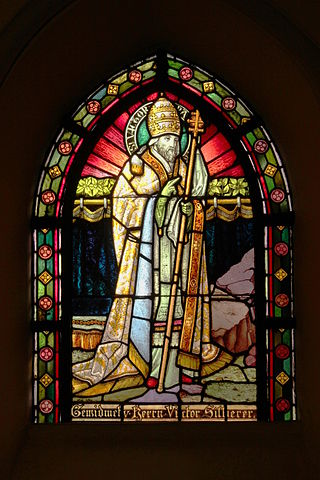
Pope Victor I was a Roman African prelate of the Catholic Church who served as Bishop of Rome in the late second century. The dates of his tenure are uncertain, but one source states he became pope in 189 and gives the year of his death as 199. He was born in the Roman Province of Africa—probably in Leptis Magna. He was later considered a saint. His feast day is celebrated on 28 July as "St Victor I, Pope and Martyr". He was of Berber origin.

Polycarp was a Christian bishop of Smyrna. According to the Martyrdom of Polycarp, he died a martyr, bound and burned at the stake, then stabbed when the fire failed to consume his body. Polycarp is regarded as a saint and Church Father in the Eastern Orthodox Church, Roman Catholic Church, Oriental Orthodox Churches, Lutheranism, and Anglicanism.

Pope Soter was the bishop of Rome from c. 167 to his death in c. 174. According to the Annuario Pontificio, the dates may have ranged from 162–168 to 170–177. He was born in Fondi, Campania, today in the Lazio region of Italy. Soter is known for declaring that marriage was valid only as a sacrament blessed by a priest and also for formally inaugurating Easter as an annual festival in Rome. His name, from Greek Σωτήριος from σωτήρ "saviour", would be his baptismal name, as his lifetime predates the tradition of adopting papal names.
Year 177 (CLXXVII) was a common year starting on Tuesday of the Julian calendar. At the time, it was known as the Year of the Consulship of Commodus and Plautius. The denomination 177 for this year has been used since the early medieval period, when the Anno Domini calendar era became the prevalent method in Europe for naming years.
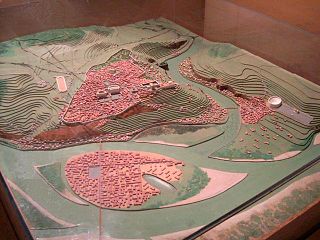
Lugdunum was an important Roman city in Gaul, established on the current site of Lyon. The Roman city was founded in 43 BC by Lucius Munatius Plancus, but continued an existing Gallic settlement with a likely population of several thousands. It served as the capital of the Roman province of Gallia Lugdunensis and was an important city in the western half of the Roman Empire for centuries. Two emperors, Claudius and Caracalla, were born in Lugdunum. In the period 69–192 AD, the city's population may have numbered 50,000 to 100,000, and possibly up to 200,000 inhabitants.

June 1 - Eastern Orthodox Church calendar - June 3
Martyrdom of Polycarp is a manuscript written in the form of a letter that relates the religious martyrdom of Polycarp, Bishop of Smyrna and disciple of John the Apostle in the 2nd century AD. It forms the earliest account of Christian martyrdom outside of the New Testament. The author of Martyrdom of Polycarp is unknown, but it has been attributed to members of the group of early Christian theologians known as the Church Fathers. The letter, sent from the church in Smyrna to another church in Asia Minor at Philomelium, is partly written from the point of view of an eye-witness, recounting the arrest of the elderly Polycarp, the Romans' attempt to execute him by fire, and subsequent miraculous events.

June 27 - Eastern Orthodox Church calendar - June 29

Saint Blandina was a Christian martyr who died in Lugdunum during the reign of Emperor Marcus Aurelius.

The Archdiocese of Lyon, formerly the Archdiocese of Lyon–Vienne–Embrun, is a Latin Church metropolitan archdiocese of the Catholic Church in France. The archbishops of Lyon are also called primates of Gaul. An archbishop is usually elevated by the pope to the rank of cardinal.

Benignus of Dijon was a martyr honored as the patron saint and first herald of Christianity of Dijon, Burgundy. His feast falls, with All Saints, on November 1; his name stands under this date in the Martyrology of St. Jerome.

The persecution in Lyon in AD 177 was an outbreak of persecution of Christians in Lugdunum, Roman Gaul, during the reign of Marcus Aurelius, recorded in a contemporary letter preserved in Eusebius's Ecclesiastical History, book 5, chapter 1, which was written 150 years later in Palestine. Gregory of Tours also describes the persecution in the 6th century in De Gloria martyrum.
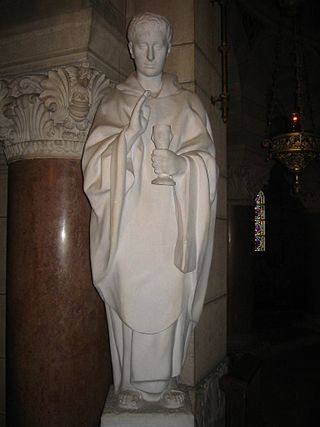
Saints Ferreolus and Ferrutio are venerated as martyrs and saints by the Catholic Church, especially in Besançon where they are honored as its patron saints.
Gaul was an important early center of Latin Christianity during late antiquity and the Merovingian period. By the middle of the 3rd century, there were several churches organized in Roman Gaul, and soon after the cessation of persecution, the bishops of the Latin world assembled at Arles in AD 314. The Church of Gaul passed through three crises in the late Roman period, Arianism, Priscillianism and Pelagianism. Under Merovingian rule, a number of "Frankish synods" were held, marking a particularly Germanic development in the Western Church. A model for the following Frankish synods was set by Clovis I, who organized the First Council of Orléans (511).
Saint Thraseas was a martyr under the reign of Emperor Marcus Aurelius. Prior to his death he served as Bishop of Eumenia, Phrygia, in Asia Minor.
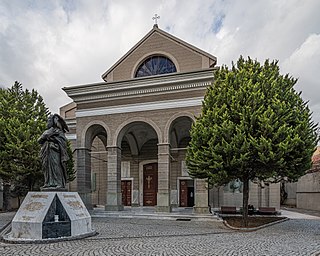
St. John's Cathedral is a cathedral in İzmir, Turkey. It is the seat of the Roman Catholic Archdiocese of İzmir. The cathedral is dedicated to John the Evangelist, who in the Book of Revelation sent greetings and instructions to the Seven churches of Asia, including Smyrna (İzmir).
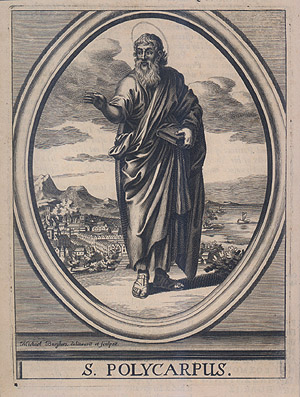
The Metropolis of Smyrna is an ecclesiastical territory (diocese) of the Ecumenical Patriarchate of Constantinople, modern Turkey. The Christian community of Smyrna was one of the Seven Churches of Asia, mentioned by Apostle John in the Book of Revelation. It was initially an archbishopric, but was promoted to a metropolis during the 9th century. Although the local Christian element was reduced during the 14th and 15th centuries, it retained its ecclesiastical autonomy continuously until 1922.

The Myth of Persecution: How Early Christians Invented a Story of Martyrdom is a 2013 book by Candida Moss, an award-winning historian and professor of New Testament and Early Christianity at the University of Notre Dame. Prior to the writing of this book Moss had published two other works on early Christian martyrdom. In her book, Moss advances the thesis that:
- The traditional idea of the "Age of Martyrdom", when Christians suffered persecution from the Roman authorities and lived in fear of being thrown to the lions, is largely fictional. Here she adapts and emends the work of G. E. M. de Ste. Croix.
- There was never sustained, targeted persecution of Christians by Imperial Roman authorities. Official persecution of Christians by order of the Roman Emperor lasted for at most twelve years of the first three hundred of the Church's history. Moss writes: "This does not mean, however, that there were no martyrs at all or that Christians never died. It is clear that some people were cruelly tortured and brutally executed for reasons that strike us as profoundly unjust."
- Most of the stories of individual martyrs amassed by the early modern period are pure inventions. She agrees with Bollandist scholar Hippolyte Delehaye that most martyrdom literature developed in the fourth century and beyond.
- Even the oldest and most historically accurate stories of martyrs and their sufferings have been altered and re-written by later editors, so that it is impossible to know for sure what any of the martyrs actually thought, did or said.

Primate of the Gauls is a title given since 1079 to the archbishop of Lyon, former capital of the Three Gauls then land of the Roman Empire, and has described the authority he has exercised in the past over the other bishops of France. The primacy of a title conferred on archbishop guarantees a theoretical jurisdiction over several ecclesiastical provinces. In France, only the title of Primate of the Gauls and Primate of Normandy, respectively assigned to the archbishops of Lyon and Rouen, are still used.
















